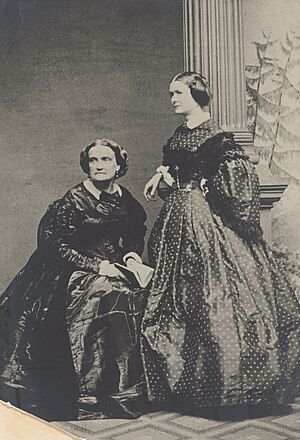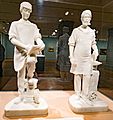Emma Stebbins facts for kids
Emma Stebbins (born September 1, 1815 – died October 25, 1882) was an American sculptor. She was the first woman to get a public art job from New York City. She is most famous for her sculpture called Angel of the Waters (1873). This work is also known as the Bethesda Fountain. You can find it on the Bethesda Terrace in Central Park, New York.
Contents
Biography
Early life and art
Emma Stebbins was born in New York City on September 1, 1815. Her father, John L. Stebbins, was a rich banker. Her mother was Mary Largin. Emma was one of nine children. Her family always supported her interest in art.
Life in Rome
In 1856, Emma's brother, Henry G. Stebbins, told her to go to Rome. He wanted her to study sculpting there. In May of that year, Emma, her younger sister Caroline, and their mother traveled to Rome. Emma and Caroline decided to live there.
In Rome, Emma met Harriet Hosmer, another American sculptor. Harriet introduced Emma to other artists and teachers. These teachers included John Gibson and Paul Akers.
Emma also met Charlotte Cushman, a famous American actress. Charlotte became a very close friend and companion to Emma. Charlotte helped Emma get important art jobs. Emma and Charlotte lived together for many years.
In September 1857, Emma and Charlotte went back to the United States. Charlotte needed to get her money back after someone stole from her. Emma stayed with her family in New York. After Charlotte finished her acting tour, they sailed to England. They traveled around Europe before returning to Rome in November 1858.
Later years
Emma Stebbins and Charlotte Cushman lived together for 12 years. Then they returned to the United States. Charlotte had breast cancer. Emma stopped her work to take care of Charlotte until she passed away in 1876.
Emma spent much of her later life writing a book about Charlotte. It was called Charlotte Cushman: Her Letters and Memories of Her Life. Emma Stebbins died on October 25, 1882, from a lung disease. She was buried in Green-Wood Cemetery in Brooklyn.
Famous Sculptures
Emma Stebbins was a neoclassical sculptor. This means her art style was inspired by ancient Greek and Roman art. She made about two dozen small marble statues. She also created two large public works in bronze. Unlike many other artists, Emma liked to carve her smaller pieces herself.
In 1842, some of Emma's art was shown at the National Academy of Design in New York. She was even nominated to become a member. However, her election was canceled because of a rule problem. Her name was never put forward again.
In 1847, Emma sent some of her oil paintings to be shown. They were displayed at the Pennsylvania Academy of Fine Arts.
While living in Rome, Emma made several statues. These included The Lotus Eater (1857-60). This piece was ordered by British sculptor John Gibson. She also made Industry (1859) and Commerce (1859). These were ordered by Charles Heckscher. Industry and Commerce were shown in New York in 1860.
In 1860, Emma also made a sculpture of Charlotte Cushman's head. Many people later asked for copies of this sculpture.
In the 1860s, Emma created other works. These included The Treaty of Henry Hudson with the Indians (1860), Sandalphon (1861), Satan (1862), and Christopher Columbus (1867). Christopher Columbus was the only life-sized marble statue Emma ever made.
Horace Mann (1865)
Around 1861, Emma was asked to create a bronze statue of Horace Mann. This statue was meant to stand in front of the State House in Boston. Charlotte Cushman, who was from Boston, was very interested in this project. Many believe she used her connections to help Emma get this important job.
Angel of the Waters (1873)
Emma Stebbins is most famous for her Angel of the Waters sculpture. It sits on top of the Bethesda Fountain in Central Park. Some people thought that Emma got this job because her brother was in charge of the Central Park committee for statues and fountains. They believed he might have helped her get the commission.
Emma was inspired by a Bible story. In the story, an angel gives healing powers to the waters of Bethesda. Her sculpture also honored the Croton Aqueduct. This system brought fresh water to New York City starting in 1842.
Legacy
We know a lot about Emma Stebbins because of her sister, Mary Stebbins Garland. After Emma passed away, Mary kept a scrapbook of her sister's work. She also wrote a book about Emma's art life. The scrapbook had photos of Emma's sculptures in order. It also had pictures of Emma and people who supported her, like Charlotte Cushman and Emma's brother Henry.
The Angel of the Waters sculpture has been in many movies set in New York. These include Angels In America, Home Alone 2, Elf, and Enchanted.
Gallery
-
The Angel of the Waters (1873) in Central Park.
-
Angel of the Waters at Bethesda Fountain.
-
The Horace Mann (1865) statue outside the Massachusetts State House.
See also
 In Spanish: Emma Stebbins para niños
In Spanish: Emma Stebbins para niños










